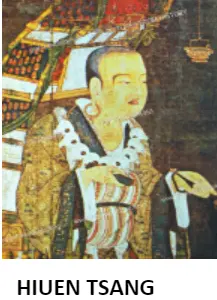Hiuen Tsang, also known as Xuanzang, was a revered Chinese Buddhist monk who journeyed to India during King Harsha Vardhana’s reign to acquire Buddhist scriptures. His travels spanned over 14 years, during which he explored various regions and studied Buddhism. Hiuen Tsang’s accounts provide valuable insights into ancient Indian history and culture, shedding light on the social, religious, and political conditions of the time.
Hiuen Tsang’s Journey to India and Contributions
1. Hiuen Tsang’s Pilgrimage to India
- Introduction to Hiuen Tsang’s Journey: Hiuen Tsang or Xuanzang was a Chinese Buddhist monk.
- He traveled to India during the reign of King Harsha Vardhana to obtain the Buddhist scriptures.
- Hiuen Tsang, also known as the “Prince of Pilgrims,” was a celebrated Chinese pilgrim and Buddhist monk.

- Purpose of Hiuen Tsang’s Journey: He traveled to India in the 7th century A.D. to deepen his knowledge of Buddhism and visit sacred sites associated with the life of Buddha.
- Exploration Across India: During his 14-year journey in India, he extensively explored various regions, studying Buddhism and observing social, religious, and political conditions.
- Hiuen Tsang visited significant places like Kashmir, Punjab, Kapilavastu, Bodh-Gaya, Sarnath, Kusinagara, and the University of Nalanda.
- Admiration from Emperor Harsha: He gained admiration from Emperor Harsha for his devotion to Buddha and profound understanding of Buddhism.
- Return to China: Hiuen Tsang returned to China in 645 A.D., accompanied by a military escort provided by Emperor Harsha.
- He carried valuable relics, Buddha images, and manuscripts back to China, translating many Buddhist works into Chinese.
- Legacy of Hiuen Tsang’s Writings: Hiuen Tsang’s writings provided invaluable insights into ancient Indian history and Buddhism, shedding light on an important era.
- His accounts of India have been regarded as truthful and trustworthy, contributing significantly to the understanding of ancient Indian civilization.
2. Observations
-
- Monastic Presence in Kashmir: When Xuanzang arrived in Kashmir in 631 AD, he discovered that the region was home to more than 100 monasteries and 5,000 monks.
- Between AD 632 and early 633, Hiuen Tsang wrote about the Fourth Buddhist council.
- Travel to Various Locations: He traveled to several locations in India, including Mathura in Uttar Pradesh, Bairat in Rajasthan, Kullu in Himachal Pradesh, and Jalandhar in Punjab.
- Despite being a mostly Hindu city at the time, Mathura was home to 2,000 monks from both of the main Buddhist orders.
- King Harsha’s Patronage of Buddhism: Hiuen Tsang was struck by King Harsha’s support of learning and Buddhism when he saw 100 monasteries with 10,000 monks, both Mahayana and non-Mahayana.
- Administration and Justice under Harsha: He praised Emperor Harsha and called him a hard-working ruler.
- Traitors received death penalties, while offenders received physical or torture punishments.
-
-
- During his rule, the kingdom was well-run and free from uprisings.
- Less taxation was levied, and land revenue was the primary source of income.
- Travel was not particularly secure at the time.
- Religious Dynamics: He called Harsha a perfect follower of the Buddha, yet at the time, Hinduism was more common in India than Buddhism.
-
-
- All religious beliefs were completely tolerated, and people freely changed their religions.
- Urban Life and Cultural Passions: He spoke of Indian city life, saying that bricks, wood, and manure were used to build the homes.
- People dressed in wool, silk, and cotton.
-
- Indians had a great passion for learning, writing, and the arts.
- He also said that women had access to education and that the strict Caste system had no purdah system, but that Sati was still the dominant religion.
Conclusion
Hiuen Tsang’s observations during his travels in India offer a glimpse into the vibrant society of ancient India under King Harsha’s rule. His admiration for Emperor Harsha’s support of learning and Buddhism, alongside his detailed descriptions of Indian life, enriched our understanding of this significant period in history. Hiuen Tsang’s writings continue to be valued as trustworthy sources for scholars studying ancient Indian civilization.
![]() May 16, 2024
May 16, 2024
![]() 11754
11754
![]() 0
0
